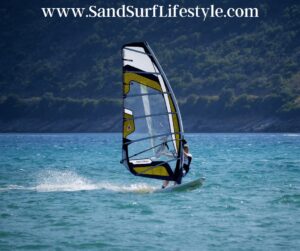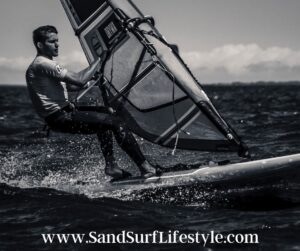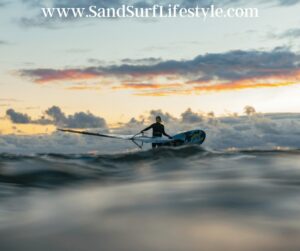The sport of windsurfing dates back to 1968 when Californians Jim Drake (a sailor) and Hoyle Schweitzer patented the first windsurfing board, which they called a windsurfer. In the five decades since its inception, the evolution of the sport of windsurfing has seen many changes. Windsurfers developed many tricks and skills, including planing. The term “planing” refers to the action of gliding over the water, as opposed to pushing through the water. The sensation of practically flying when you are planning is one of the biggest thrills you can get when windsurfing.
Back Position
 The two most important positions for your body when you are windsurfing are the positions of your feet and your back. The website How To Windsurf 101 suggests allowing your back to fall far enough for it to get wet. They also suggest keeping your body tension, not allowing it to become loose. This is crucial for being able to generate enough power to plane.
The two most important positions for your body when you are windsurfing are the positions of your feet and your back. The website How To Windsurf 101 suggests allowing your back to fall far enough for it to get wet. They also suggest keeping your body tension, not allowing it to become loose. This is crucial for being able to generate enough power to plane.
When you are trying to position your back properly so that you can plane when you are windsurfing, it is important to remember not to lean back far enough that your weight is not completely on the board. Doing this will allow your windsurfing board to sink more quickly than you would expect. The technique of planing requires your windsurfing board to be slightly above the water. Improper back positioning will ensure that you do not successfully plane because it will cause your board to be under the water.
While you are practicing proper back positioning when you are windsurfing oh, it is also very important to keep your safety in mind. Back injuries are a frequent occurrence in sports. It is important to remember to know your limits for a safe and successful day of planing.
Sheeting In
Sheeting is just one of many aspects of the sport of windsurfing. The technique of sheeting refers to “pulling with your back hand on the sail, with the pulling pressure coming from either shoulder rotation or extending your legs or flexing your arm,” per Google Groups. Also referred to as sheeting in, the proper position to achieve the speed you will need to plane requires you to be sheeted in at an angle near the top of the curve.
Being partially sheeted in without proper positioning will result in much slower speeds, which means you will not be able to achieve the technique of planing. When sheeting in, it is of the utmost importance to try to keep your sail as vertical as possible. The Windsurfer Loop says that if you are using a short windsurfing board, you will not be able to successfully plane if your sale is not fully sheeted in.
Being able to sheet in is harder than it looks. However, it is a technique that is necessary if your goal is to feel the exhilaration and excitement that the planing technique can provide. It is essential to a fun day of windsurfing.
Hip Position
 Your hip position can generate both torque and Power in just about any sport. We have already discussed the importance of the position of your feet and back when surfing. The position of your hips is also a determining factor of successfully planing. According to Jem Hall, keeping your head below the boom and proper hip position and usage well allow you to achieve better balance when you are trying to plane.
Your hip position can generate both torque and Power in just about any sport. We have already discussed the importance of the position of your feet and back when surfing. The position of your hips is also a determining factor of successfully planing. According to Jem Hall, keeping your head below the boom and proper hip position and usage well allow you to achieve better balance when you are trying to plane.
Your hips should be pushing forward while also using your front foot to push towards the nose of the windsurf board. Your hips also had the responsibility of being one of two important aspects when it comes to your ability to balance well. Used in conjunction with your foot position, your hip position will play a key role in your balance. This will not only allow you to achieve better planing, but it will also allow you to maintain your plane once you have started to plane.
Once you have found the right position for your feet and hips that suits you best when windsurfing, you will be able to not only start the technique of planing quicker oh, but you will be able to also maintain planing for longer times and distances.
Looking to buy a scuba regulator but not sure which one to get?
Here are the 7 most reliable scuba regulators you can buy.
Sail Power
Achieving good sail power is a key factor in being able to plane. Without good sail power, you will not be able to windsurf. If you are not able to successfully windsurf, you will certainly not be able to plane. Hip and head position are important aspects in achieving better sail power. Surfer Today also suggests making sure that your sail is big enough to get adequate wind power.
If you want to successfully plane, having a small sail simply won’t be sufficient. Of course, you will need to make sure that your sail is large enough to generate more wind power but small enough for you to handle wow. Some sails are simply too large for some people to be able to handle adequately. All of the Power for planing may be generated from your sail, but your body position is quite important and being able to generate enough wind power to plane.
I firmly believe that sell power is the single most important aspect of a great day of windsurfing. After all, if you do not have sufficient wind power, you will not be able to plane. By making sure that you have a large enough sail and have proper foot and back positioning, you will be able to harness plenty enough wind power to be able to plane while you are windsurfing.
Being Fearless
 Technically speaking, being fearless isn’t a technique. However, just like with any other sport, fear can be severely detrimental when you are windsurfing. Sport and Wisdom states that you don’t necessarily need to be fixated, charged up, or amps to be fearless in any sport. Instead, you need to Simply put yourself in a different mindset and have the capability to think differently.
Technically speaking, being fearless isn’t a technique. However, just like with any other sport, fear can be severely detrimental when you are windsurfing. Sport and Wisdom states that you don’t necessarily need to be fixated, charged up, or amps to be fearless in any sport. Instead, you need to Simply put yourself in a different mindset and have the capability to think differently.
Let’s try this technique to eliminate being scared. Try to change your mindset to project confidence instead of exuding fear. Being fearful in both sports and life can make you hesitant, which can hinder success in anything you are trying to accomplish. As a beginner, you will fall many times when you are trying to master the technique of planing when surfing.
Let’s get one thing straight. You will get wet, and it will happen quite often. Embrace it, don’t be afraid of it. After enough practice oh, you will be able to conquer any fear you have. Soon, you will be able to plane like you have been windsurfing for your entire life.
Conclusion
Of all of the tricks and techniques you can use when windsurfing, planing is said to be the most exhilarating. This is the technique that didn’t see the sense of flying rather than surfing. By letting your body fall back far enough to get wet; sheeting with your sail; pushing your hips forward horizontally; keeping power in your sail; and not being afraid to fall, you will be able to master the technique of planing in no time.
If you want to be able to master the technique of planing, it is quite important to remember that you will need to practice this technique frequently. Once you have learned how to plane and felt the exhilaration that this technique provides, your windsurfing will be taken to the next level. It will become more than a passion. It will be a way of life.
Please note: This blog post is for educational purposes only and does not constitute legal or medical advice. Please consult a legal expert or medical professional to address your specific needs.

